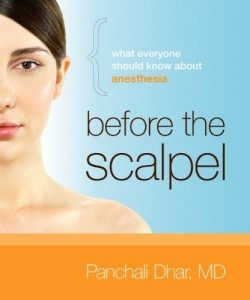Before the Scalpel
What Everyone Should Know About Anesthesia
Most people will require anesthesia for a medical procedure in their lifetime; whether it’s full anesthesia for surgery, regional anesthesia for the birth of a child, or local anesthesia for a tooth extraction. Every year, more than seventy million Americans receive anesthesia, although very little has been published on the subject for the healthcare consumer. Before the Scalpel fills this void.
The book’s fourteen chapters are arranged in chronological order based on the surgery timeline. The first two chapters describe the training required of each anesthesiology team member as well as their responsibilities beyond administering the drug cocktail (gas, narcotics, memory blockers, and muscle relaxants) which renders sleep. Also included are descriptions of the standard types of anesthesia and how each is administered. The patient scoring system doctors use to help them avoid the complications often associated with anesthesia is rendered in detail.
The next five chapters explain what patients can expect the day of surgery as well as what happens inside the operation room and the recovery room. A chapter is devoted to post-operation pain management. Final chapters cover special topics like elective (cosmetic) surgery, how anesthesia affects obese patients and childbirth, and anesthesia for children and dentistry.
Before the Scalpel is an authoritative look at an important healthcare topic. Dr. Dhar is a board certified anesthesiologist and assistant professor of Clinical Anesthesiology at New York-Presbyterian Hospital/Weill Cornell Medical College. Her work has been published in leading medical journals and medical textbooks. Here, she uses non-technical language to dissect the complex topic of anesthesia for the average consumer. Each chapter contains sidebars of supplemental information and a checklist of questions to ask the doctor before surgery. A “Reference and Tools” section at the end includes a brief overview of anesthesia history and a glossary.
Although there are many valuable illustrations with complimentary text, the least attractive part of this book is the abundance of stock photography that does not add value. Examples include a morning sunrise to demonstrate how early anesthesiologists arrive at the hospital, and a grocery bag of fruits and vegetables to encourage healthy eating during post-operative care. These photos seem more appropriate for a high school textbook than an adult consumer publication. Despite this distraction, the content covers the topic thoroughly—something the millions of Americans who may need anesthesia over the next year will find useful.
Reviewed by
Angela Black
Disclosure: This article is not an endorsement, but a review. The publisher of this book provided free copies of the book to have their book reviewed by a professional reviewer. No fee was paid by the publisher for this review. Foreword Reviews only recommends books that we love. Foreword Magazine, Inc. is disclosing this in accordance with the Federal Trade Commission’s 16 CFR, Part 255.

